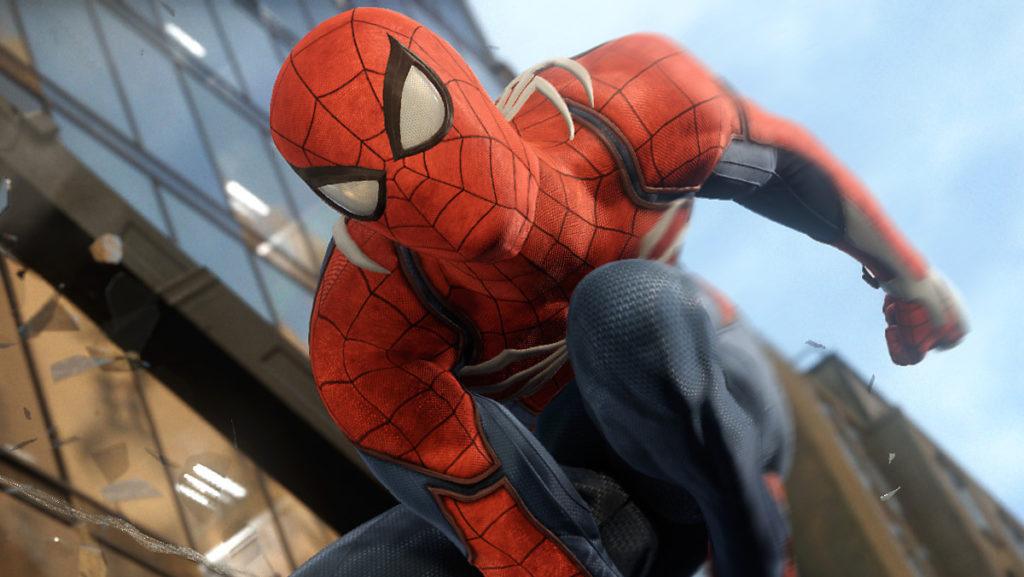Spider-Man climbs the side of the Avengers Tower, a vast endless wall of glinting glass. He skitters up the top, hand over hand, until he reaches the highest spire. He sits for a moment, staring out across his city, and then jumps, arms outstretched, hurtling toward the ground. And just before Spider-Man splatters onto the pavement, you press R2; he thrusts out his hand, fires a web and swings away, soaring above the New York City skyline.
It’s a magical moment that you’ll experience dozens, if not hundreds, of times as you fight and fly your way through the best Spider-Man game to date.
(Spoilers ahead — proceed with caution.) “Marvel’s Spider-Man,” Insomniac Games’ third-person action adventure features the beloved web-swinger eight years into his career. Peter Parker (Yuri Lowenthal) has already encountered the individual members of the Sinister Six, King Pin and Black Cat, but his greatest villain — Otto Octavius (William Salyers), aka Doc Ock, the mad scientist with four sentient metal tentacles — has yet to break bad. Instead, Peter and Otto are colleagues and friends at the beginning of the game. Insomniac blends classic Spider-Man elements with modern twists, making Peter so much more than the stammering, broke college student he was at his inception.
Peter and Otto’s relationship is the focal point on which the story turns. Though two-thirds of the game is spent in pursuit of the supernatural crime boss, Mr. Negative (Stephen Oyoung), Otto’s descent into villainy and his ultimate betrayal of Peter are the emotional core of the game. Their father-son bond deteriorates as Otto’s obsession with taking down the mayor of New York City consumes him. The final fight between Peter and Otto, set atop a towering building as rain pelts down, ends with an emotional conversation between Peter and his mentor, his surrogate father. Despite starting and ending strong, Otto’s story falls apart in the middle. It’s frustrating that Otto’s villainy is so cartoonish and absurd. He leaps from a gentle altruist at the beginning of the game to a large-scale, genocidal terrorist at the end. It’s a shift that feels incongruous even after it’s explained that the cybernetic tentacles meddle with his brain chemistry.
Mary Jane (Laura Bailey) also gets a refreshing update. No longer is she nothing more than Peter’s improbable love interest; instead, she’s a capable, compelling character of her own. She’s a journalist, not a model like she is in the comics: She’s more Lois Lane than perpetual damsel. Watching her and Peter try to rebuild their relationship — they’ve been broken up for several months at the outset of the game — is emotional and poignant. It’s a relatable story about the struggle of balancing a career with a relationship.
“Spider-Man” works better as a story than a game. Though swinging between glittering skyscrapers and webbing up enemies is fun at first, it gets old fast. Combat encounters, especially the base challenges that lock Peter into an area and force him to fight waves of enemies, become repetitive and dull. Insomniac attempts to alleviate the repetition with the myriad of gadgets Peter has access to. Unfortunately, to switch weapons, you have to pull up a tool wheel that freezes combat and undermines any sense of urgency. Even the initial thrill of unlocking a new suit loses its luster when you realize that you’ll have to earn tokens to get a chance to wear it.
A peculiar paradox arises as you swing, zip and soar through the loving recreation of New York City: Insomniac made a world that’s fun to inhabit but not a game that’s fun to play. Every mission and side quest — find and detain a flock of escaped pigeons, take pictures of all of New York’s iconic landmarks — feels like a chore, but the simple act of pressing R2 to swing is enough overshadow the tedium. The side activities become a means to an end; if you want to unlock new suits and gadgets, you need tokens, and if you want tokens, you need to engage with the glut of systems Insomniac crammed into the game.
Insomniac’s version of Spider-Man is not only the best video-game adaptation of the scarlet web-slinger but the best onscreen take on the character. Spider-Man and Peter Parker are shown equal love and attention; Insomniac made a story in which Peter’s personal drama is as compelling as his costumed adventures. Though the gameplay gets a bit stale by the time the credits roll, the core game — the story, the costumes, the ceaseless charisma of Lowenthal’s Peter — is a consistent source of superhero joy.















